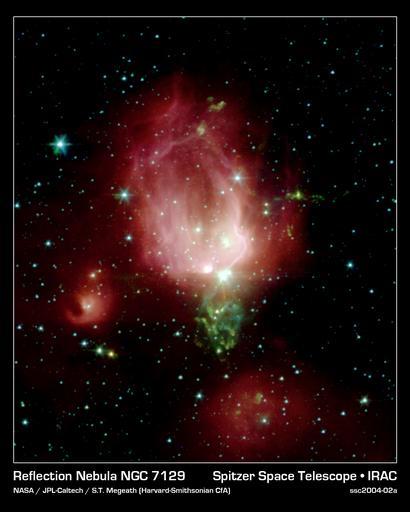MAKE A MEME
View Large Image

| View Original: | NGC_7129.jpg (1200x1500) | |||
| Download: | Original | Medium | Small | Thumb |
| Courtesy of: | commons.wikimedia.org | More Like This | ||
| Keywords: NGC 7129.jpg en A cluster of newborn stars herald their birth in this interstellar Valentine's Day commemorative picture obtained with NASA's Spitzer Space Telescope These bright young stars are found in a rosebud-shaped and rose-colored nebulosity known as NGC 7129 The star cluster and its associated nebula are located at a distance of 3300 light-years in the constellation Cepheus A recent census of the cluster reveals the presence of 130 young stars The stars formed from a massive cloud of gas and dust that contains enough raw materials to create a thousand Sun-like stars In a process that astronomers still poorly understand fragments of this molecular cloud became so cold and dense that they collapsed into stars Most stars in our Milky Way galaxy are thought to form in such clusters The Spitzer Space Telescope image was obtained with an infrared array camera that is sensitive to invisible infrared light at wavelengths that are about ten times longer than visible light In this four-color composite emission at 3 6 microns is depicted in blue 4 5 microns in green 5 8 microns in orange and 8 0 microns in red The image covers a region that is about one quarter the size of the full moon As in any nursery mayhem reigns Within the astronomically brief period of a million years the stars have managed to blow a large irregular bubble in the molecular cloud that once enveloped them like a cocoon The rosy pink hue is produced by glowing dust grains on the surface of the bubble being heated by the intense light from the embedded young stars Upon absorbing ultraviolet and visible-light photons produced by the stars the surrounding dust grains are heated and re-emit the energy at the longer infrared wavelengths observed by Spitzer The reddish colors trace the distribution of molecular material thought to be rich in hydrocarbons The cold molecular cloud outside the bubble is mostly invisible in these images However three very young stars near the center of the image are sending jets of supersonic gas into the cloud The impact of these jets heats molecules of carbon monoxide in the cloud producing the intricate green nebulosity that forms the stem of the rosebud Not all stars are formed in clusters Away from the main nebula and its young cluster are two smaller nebulae to the left and bottom of the central rosebud each containing a stellar nursery with only a few young stars Astronomers believe that our own Sun may have formed billions of years ago in a cluster similar to NGC 7129 Once the radiation from new cluster stars destroys the surrounding placental material the stars begin to slowly drift apart 2004-02-12 http //www spitzer caltech edu/images/1127-ssc2004-02a-Rosebud-of-a-Reflection-Nebula NASA/JPL-Caltech/T Megeath Harvard-Smithsonian CfA Image use policy http //www spitzer caltech edu/info/18-Image-Use-Policy This image is from NASA's Spitzer Space Telescope and was their 2004 Valentine's Day release the cosmic rose More information is available at http //www spitzer caltech edu/Media/releases/ssc2004-02/release shtml PD-USGov NGC 7129 Spitzer space telescope NASA images | ||||